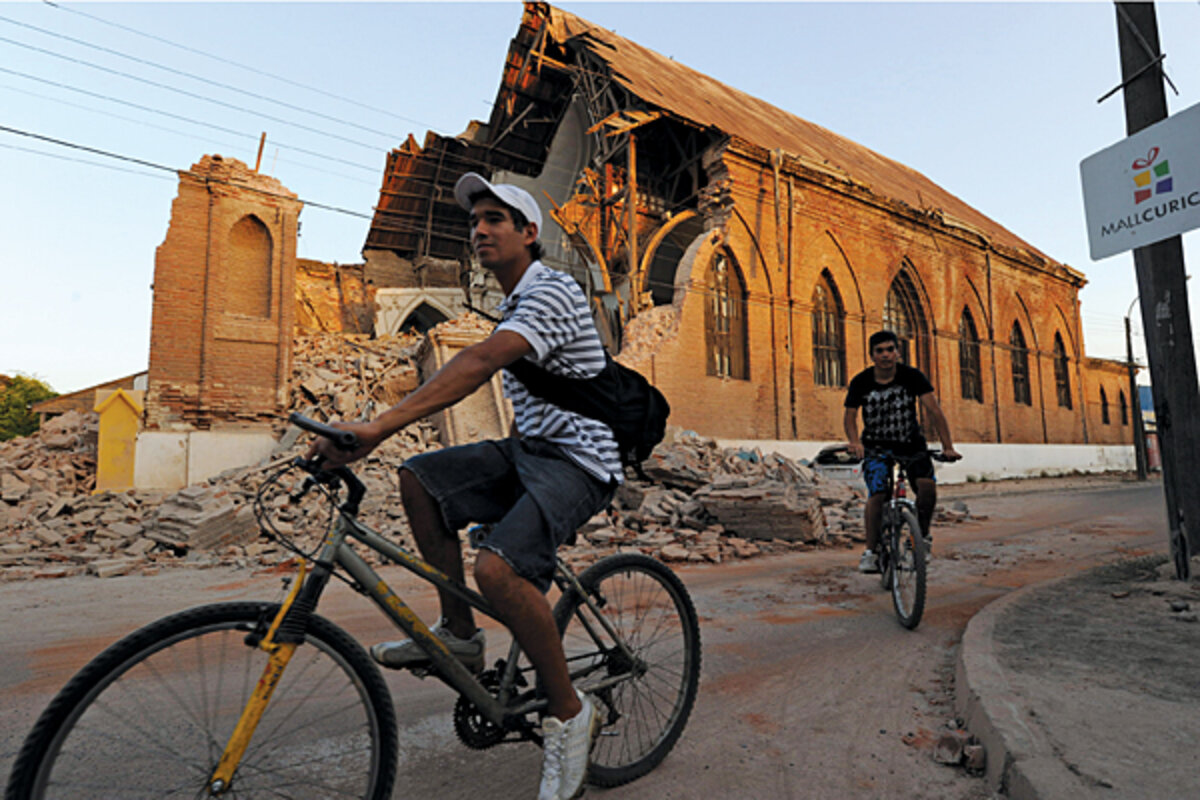Chile earthquake takes heavy toll on historical sites
Loading...
| Santiago, Chile
When the massive magnitude-8.8 quake that rocked Chile on Feb. 27 reduced dozens of the country’s oldest historical sites to rubble, Oscar Acuña wasted no time before dispatching teams of architects and archaeologists to assess the damage. In the capital, Santiago, the quake damaged a handful of churches and buildings in the historic districts. But in the traditional towns nearest the epicenter none was spared.
Initial assessments of 241 damaged sites include the San Salvador Basilica in Santiago and the World Heritage sites of La Matriz Church and the Port marketplace, both in the coastal city of Valparaiso.
The most extensive damage, however, occurred in the south-central regions of Maule, O’Higgins, and Biobio, where many adobe homes were destroyed.
IN PICTURES: Rebuilding after an earthquake
Mr. Acuña, executive secretary of Chile’s National Monuments Council (NMC), now finds himself in a race against the clock to prevent demolition crews from erasing what remains of these culturally important sites.
“This is not the time to be hasty,” Acuña says. “We’re asking communities to pause before they demolish these buildings because once they’re gone, the loss is total.”
The Jan. 12 earthquake in Haiti also destroyed many well-known symbols of the island nation’s cultural heritage, such as the National Palace and the Holy Trinity Cathedral. The United Nations and other international groups are evaluating the damage to develop a strategy for preserving such sites, while in Chile the government itself is taking the lead role.
The NMC and the National Center of Conservation and Restoration are overseeing the damage assessment in collaboration with religious and historical organizations, architects, and architectural students. Where the NMC’s focus is primarily on the edifice, the conservation and restoration center is concerned with the altars and other objects often as significant as the buildings themselves.
Big impact on religious sites
The earthquake was especially costly for the religious community. Nearly 3 out of every 4 cultural patrimony buildings damaged belong to the Roman Catholic Church, according to Maria Elena Troncoso Delpiano, executive secretary of the National Commission of Cultural Property of the Church. “Building in Chile is generally an optimistic endeavor because sooner or later we all know another quake is imminent,” Ms. Troncoso says. “We’ve built beautiful things, but we aren’t prepared to conserve them.”
Scores of 100-year-old churches and chapels crumbled, while hundreds of aftershocks continue to shake the ground in Chile, finishing the job of ruining partially damaged structures.
The quake exposed longstanding neglect, especially of religious monuments, Troncoso adds. But as far as she is concerned, everything is repairable, and the commission has been working with priests to inventory church losses.
But in many cases, the teams of architects have arrived to find the city has already demolished damaged buildings.
Government quick to demolish
One such building is Jenny Figueroa’s home in Santiago’s historic neighborhood of Barrio Brasil. After the second floor crumbled under the force of the quake, the family of 17 and seven tenants spent several nights sleeping on the street, too scared to go inside but unwilling to leave their home. When help finally arrived days later the diagnosis was simple and immediate: Take it all down.
“We intend to defend this house whatever the consequence,” Ms. Figueroa says. “Where else can we go? The street?” With the help of the NMC, the Figueroas persuaded the government that the ground floor, which they now occupy, can be restored. That’s not the case for their neighbors, whose building is scheduled to be demolished.
“The government considers these homes a danger and wants to get rid of them before the next big earthquake,” Figueroa says. “But what are we talking about here? Buildings that are barely two years old fell to the ground, and ours is still standing.”
Maria Paz Valenzuela, a professor of architecture at the University of Chile, coordinates the nation’s architectural archive, which contains the blueprints and historical information of Chile’s key cultural buildings. She has been working alongside Acuña’s teams from the NMC.
Like Acuña, Ms. Valenzuela sees the urgency. “Obviously there is a need to house the people who lost their homes,” she says. “But I think we have to wait until the dust settles before we demolish everything and replace it with buildings that have no identity.”
Pressing needs continue
Much can be saved, Acuña says, though the biggest challenge facing Chile is securing the resources to rebuild. A good start would be an overhaul of Chile’s outdated monuments law. From the perspective of providing incentives the law is obsolete, according to Acuña. He says the NMC’s yearly budget is less than $2 million.
“The owner of cultural patrimony has no economic support that helps or encourages him with conservation,” Acuña says. “We have an opportunity now to create incentives for owners to preserve buildings.”
One source of funding is the state, but Acuña expects business interests to play a key role in restoring Chile’s historic sites. There has already been widespread interest in working with the NMC to rebuild, a process expected to take years. Right now the most pressing need is to find thousands of yards of plastic to cover damaged buildings’ exposed adobe before the rainy season begins.
“The earthquake happened and for many people it’s over,” Acuña says. “But for us the subject of cultural patrimony will go on for years to come.”




